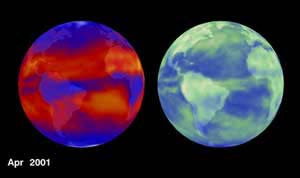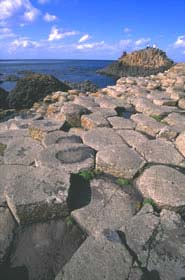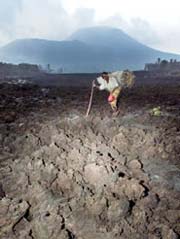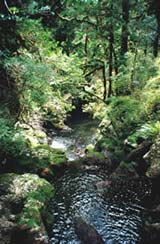New analysis of the remains of two ‘puppies’ dating back more than 14,000 years ago has shown that they are most likely wolves, and not related to domestic dogs, as previously suggested. The genetic analysis also proved that the cubs were sisters at the age of around two months, and like modern day wolves had a mixed diet of meat and plants. Researchers, however, were surprised to see evidence of a wooly rhinoceros as part of their last meals, as…

Climate prediction just got trickier, according to two new studies appearing in the current issue of the journal Science. Analysis of more than two decades of satellite data shows that more sunlight entered the tropics and more heat escaped to space in the 1990s than a decade earlier. Moreover, current climate models fail to account for the new findings, suggesting that they may contain more uncertainty than previously thought.
For the earth’s climate to remain unchanged, the planet’s ener

Smart process cleans up contaminated water.
A smart material identifies and destroys toxic pollutants in water. When exposed to the offending molecules, tiny light-emitting zinc oxide particles glow dimly, burn them up, and glow brightly to show they’ve finished 1 .
The advantage of such an approach, say Prashant Kamat and co-workers at the University of Notre Dame in Indiana, is that the energy-consuming burn-up stage switches on only when pollutants are pre

Scientists from Newcastle University are using llama droppings to help combat environmental problems caused by polluted water seeping from abandoned silver and tin mines in the Bolivian Andes.
The project is being spearheaded by Paul Younger, Professor of Hydrogeochemical Engineering at Newcastle University. It has been adapted from a community-based natural regeneration technique which uses waste materials to treat polluted mine waters. Professor Younger pioneered the technique, along with

Researchers from the University of Amsterdam have demonstrated that the climate in South Mexico changed following the collapse of the Maya empire. From preserved pollen grains the paleoecologists could deduce that the climate quickly became dryer.
The climate becoming dryer, explains the decrease in the population following the collapse of the Maya empire. The climate researchers have therefore helped to solve an archaeological mystery.
With the help of pollen grains, the paleoeco

Ireland’s huge hexagonal columns are a natural consequence of lava cooling.
The Giant’s Causeway is not the work of men or monsters, but a natural consequence of how lava cools and solidifies, new computer simulations suggest.
The causeway is a field of roughly hexagonal basalt columns up to 40 feet high on the shores of County Antrim in Northern Ireland. It arose when a flow of volcanic rock split into hexagonal columns to relieve stress, according to Eduardo Jagla

The delicate balance of life and death in Africa is nowhere more evident than on the banks of the continent`s mighty rivers. Rural communities depend on the rich silt brought down by rivers for farming but they are also at risk of devastating floods, as are urban dwellers in informal settlements that are often built on floodplains.
Dr Sue Marriott, reader in earth sciences at UWE`s Faculty of the Built Environment, is setting off this month to help with training environmental managers in fl

Common or garden straw could be a rich source of raw materials for a range of industries, from the health foods and cosmetics sectors to packaging and fabrics.
Researchers at the University of Wales, Bangor are developing environmentally friendly ways of processing wheat and other cereal straws to extract valuable products for industry.
The work is being carried out through the Government’s LINK scheme, with funding from the Swindon based Engineering and Physical Sciences Research Coun

Results from a 20-year study reveal dramatic ecological changes to lakes in Antarctica caused by a 1°C temperature increase. The findings, reported this week in SCIENCE, are yet more evidence of extreme changes in the Antarctic Peninsula region. This area has experienced some of the most rapid warming of anywhere on Earth in the past 50 years (2.5°C). The study lakes, on Signy Island, lie some 700 km north-east of the Antarctic Peninsula.
Scientists from the Cambridge-based British Antarctic Surv

Scientists received several day’s warning of abnormal seismic activity.
Two seismological stations on Mount Nyiragongo in eastern Congo gave several days’ advance warning of the volcano’s possible eruption, scientists working in the area say.
But the lack of a functioning government in the war-torn region may have prevented the evacuation of the nearby city of Goma, where 45 were confirmed dead and an existing humanitarian crisis was worsened by the eruption.

Scientists examining the work that influenced Charles Darwin have rediscovered the details of what may be the world’s first ecological experiment.
Darwin, in his Origin of Species of 1859, referred to an experiment investigating the biology of grassland plants that showed how a greater diversity of grasses planted in experimental plots was responsible for greater production of plant matter. This subject, the relationship between biodiversity and the functioning of ecosystems, is curre

South American streams call current nitrogen-cycle theory into question.
Pollution may have altered northern hemisphere forests dramatically. The surprise finding that clean forests use nitrogen differently to polluted ones emphasizes the effect that humans have on the planet’s nitrogen cycle 1 . It may even prompt a rethink of the way that this cycle works.
Humans have added vast amounts of nitrogen to the earth’s ecosystems. The element fertilizes plants. T

The atmosphere and oceans exist in a delicate state of balance according to research co-ordinated by the University of East Anglia (UEA) and published this month by the Natural Environment Research Council (NERC).
The recently completed five year research programme of Atmospheric Chemistry Studies in the Oceanic Environment (ACSOE) concludes that atmospheric pollution travels much further than previously thought and that this has important consequences for global chemistry and climate.

One of the really big challenges in anthropology is to date accurately the arrival of humans in the different continents. New results, to be published in a forthcoming issue of the Journal of Quaternary Science, show that humans arrived in Australia a lot earlier than was previously thought.
It is generally argued that humans evolved in Africa and then spread out over the other continents progressively through time, arriving in the most distant, such as Australasia, relatively recently. The

One of the more controversial environmental issues, which emerged in the final years of the Soviet era, was the plan to dam and reverse the flow of north-flowing rivers in order to irrigate the dry southern steppes. This scheme was roundly criticised by scientists and environmentalists at the time because of fears for the impact on the Arctic Ocean and global climate. It now appears that nature performed this experiment some 90,000 years ago.
This months issue of the Journal of Quaternary

A novel research project is looking at ways to recycle plastic bottles for use in the fashion industry in a bid to halt the landfill crisis.
Although recycled PET (Polyethylene terepthalate) has been used in a limited way in the fashion industry, Northumbria University PhD student Yukie Nakano is working to identify the barriers affecting the wider introduction of recycled textile products. Yukie, who is also a research assistant in the Centre for Design Research, is also experimenting with

“The occurrence of ozone mini-holes over Europe increases and any ozone layer recovery could only become measurable around 2010 at the earliest” concludes an assessment report, released today, on European research in the stratosphere. The report concerns loss of ozone, increases in ultraviolet radiation as well as the impact of aircraft on the atmosphere. It covers European research efforts during the period 1996-2000 including the Third European Stratospheric Experiment on Ozone – THESEO, which is t